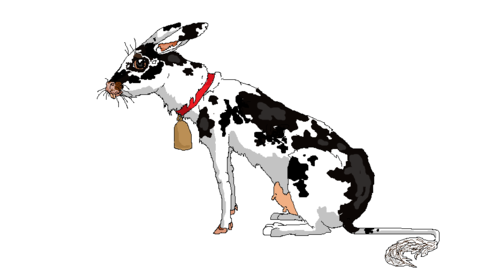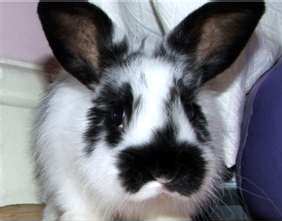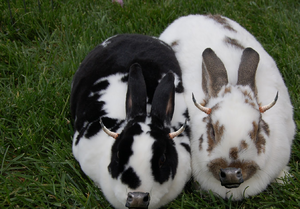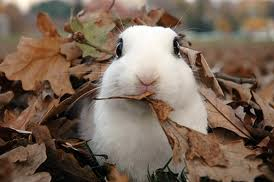Rabbit Cow
The common, or greater, rabbit cow (Oryctolagus taurus), not to be confused with the rabbit, or the cow, or a muffin, is a medium- to large-sized herbivore native to grasslands and mixed woodland throughout most of the northern hemisphere. Also known throughout its range as the hopper steer or the cottontail yak (even though most breeds actually carry the long tail of their cattle ancestors as opposed to the fluffy one of their rabbit ancestors), the wild species attains a weight of just under five hundred pounds. However, the largest breeds of domesticated rabbit cows reach over 900 pounds at maturity and may stand up to seven feet tall upright, and the smallest breed, the double-donna-super-triple-mini-munchkin may weigh less than a pound. Until recently, the rabbit cow was classed along with the bovines (mainly from behavioral similarities), but more recent studies seem to indicate a closer relation to the rabbit family than previously believed, resulting in the rabbit cow's reclassification into the rabbit family, the Leporidae.
The rabbit cow is quite variable in both color and body shape, and they can occur in virtually any color from white to red to a rich, chocolate brown to black and anything in between as well as piebald. Rabbit cows, unlike their rabbit ancestors, have the long swishing tail common to all cattle and many breeds have pronounced horns. All female rabbit cows of all breeds also have a usually pink but sometimes tan udder, and in the dairy breeds this is very pronounced. Rabbit cows have cloven hooves on the front feet and fluffy, five-toed paws on the hind legs (except for the Virginia Chinstart, which has hooves on the rear legs as well as the front, and the Dutch Curlyface, which has no hooves at all.). They travel predominately on all fours in an awkward plantigrade walking gait (like a polar bear would do) but when pursued alternate to a long, bounding hop. While able to leap over 30 feet in a single bound, most rabbit cows prefer to avoid strenuous activity, and this is even more important in many domestic breeds with genetic heart problems.
Rabbit cows, particularly the large Icelandic breeds, are noted both for their luxuriant, silky pelts and their unexcelled milk production, up to 3,700 gallons per year in some exceptional individuals. Sweeter than honey and thick enough to cut with a knife, the gelatin-like milk of the rabbit cow is renowned for it's creamy texture and high fat content (usually between 10 and 95%), which makes it ideal for making butters and high-fat cheeses or other products such as soap or shampoo.
Evolution[edit]
The ancestors of the rabbit cow are not easy to determine, but it is believed that at some point may millions of years ago they descended from an unusual mating between the distant ancestors of two very different mammals - the cow and the rabbit (although some rather stupid scientists argue it was the wildebeest and the capybara). Finding a niche too small to be filled by cattle but too expansive for rabbits, the rabbit cow evolved, carrying the best traits of both of it's ancestral species, to fill the availability. Whatever the case, the rabbit cow itself has been around virtually unchanged for half a million years.
Ecology[edit]
Great herds of rabbit cows, often numbering in the thousands, live scattered throughout the Northern hemisphere in any habitat where the grasses, herbs and forbs it depends on grow in any abundance. Often semi-migratory, rabbit cows will meander high into the mountains in summer, where it feed on the nectar-rich blossoms of honeysuckle, crabapple, and peppermint, and will then return to low lying valleys in the winter, when they feed mainly on the grass preserved beneath the snow, on tuberous root vegetables (mainly horseradish and skirret) and on twigs and bark. Rabbit cows are well known for their ability to survive on almost any diet so long as it supplies lots of calcium and isn't too fatty. Because of this, the rabbit cow can go for months eating only dry sticks or straw, but milk production is highest on a high-protein, low fat diet of clover, cereals, fresh fruits and vegetables and an occasional nestling rodent or birds' egg. While the rabbit cow certainly enjoys eating bacon, either raw or broiled, it is known to cause heart disease in the species and so consumption should be limited to less than eight pounds per day, and the same with other high-calorie foods like apricot preserves or stuffed cabbage. While not harmful, it is also best to avoid raw cucumbers, dandelions, lettuce, celery, okra, melons, and pistachios.
Living predominately in the open grasslands, the rabbit cow performs a vital service by eating virtually any plant and cropping it right down to the soil, and then delicately digging up the roots and eating them as well. In fact. herds of rabbit cows are so thorough in nibbling away every last piece of plant matter that they help prevent the overpopulation (or existence) of most other herbivorous animals in most places that rabbit cows live. In fact, it is only because of this lack of any competition from the stupid little gazelles or big stinky buffaloes that make life hell or most other herbivores that the rabbit cow has blossomed into such a rich, incredibly biodiverse species. There are very few herbivores that can compete with the rabbit cow, but because of it's unique diet, consisting mainly of the hug-of-instantaneous-death fern, the Spiny-tailed Ghahonky has been known to.
While an adult rabbit cow living in a stable family group (known as a stabbing) has few predators other than perhaps the Gibbon, juveniles fall prey to a host of carnivores, including bears, wolves and badgers in the far north and more bears, squirrels, foxes, and large owls in the south. Lacking any real defenses, when threatened a rabbit cow will usually choose to flee while screaming. Running at upwards of sixty miles per hour in brief bursts, the rabbit cow rivals the cheetah in speed, but is not nearly good at running down small antelopes or being poached into extinction for a spotted pelt. However, running is not always an option, such as when a rabbit cow is sleeping three miles out to sea and is suddenly interrupted by a horde of hungry opossums. In this case, its best option is to fight using its sharp front hooves and kicking with its powerful hind limbs to sever the jugular of its aggressor.
While wild rabbit cows rarely live for more than six years, they have been known to live for over twenty in captivity.
Reproduction[edit]
Rabbit cows nest one to six, maybe even seven times yearly after they hit sexual maturity, usually at four years old. The animals are promiscuous and males may service up to two females a season. Immediately after a week after they mate, the female begins a frantic search for a patch of soft soil in which to dig her maternity burrow. While her rabbit instincts tell her to dig a burrow for her babies, her bovine instincts tell her to chew regurgitated grass and swish her tail until the newborn drops out of her, look at it, and then to continue chewing and swishing. Eventually, the conflicted female will become so confused she wanders from the nest and meanders around aimlessly until, after a gestation period that lasts between 31 and 285 days long, she gives birth wherever she stands. Only then will she possibly dig a burrow, and even if she does it is often no more than a shallow depression in the earth.
Within days, the young leave the burrow and follow their mother as she forages. By two weeks old they start to nibble on plants and can run as fast as the adults. If mother is in good physical condition and her milk is rich, the young may be weaned by the following spring. Once weaned, the young animals have a fairly high chance of survival, unless they are killed by bears which almost all of them will be.
Domestication[edit]
The rabbit cow was domesticated between 4,500 and 1,200 B.C. by the ancient Phoenicians, who revered it for it's milk production. By 150 A.D., the rabbit cow had spread throughout much of Europe and was well known in Egypt. By the next century it was common in Rome and China. Even though there is absolutely no evidence of its existence or writing even mentioning it, the rabbit cow was undeniably the most important animal ever to reach continental Europe and Asia.
Modern rabbit cow breeders continue to refine the domestic (or fancy) rabbit cow into ever more diverse varieties, of which there are now over 400. By far, the most economically important breed is the harelstien, the stereotypical black and white dairy breed, but other important breeds include the Jersey ( another popular dairy breed), the angora (bred for it's luxuriant pelt), the Dutch toothless (self explanatory), the miniature lop eared (a small breed bred as an exotic housepet for the wealthy}, the Orange Galloway (A fierce, aggressive breed noted for it's strength and agility and prized by rabbit cow fighters) and the Liptov Blue Chinchilla Baldspotted Rex Lionheaded Angus Argyllia Swiss Roman Reddling (An ancient multipurpose breed that is both an excellent milk producer, a charming pet, and a scrumptious entree.)
As food[edit]
Rabbit cows, while cute, intelligent, and friendly, are unfortunately also incredibly delicious and so some 30 million are slaughtered annually in the United States alone. Ground up and slopped on a bun, little compares to the taste of rabbit cow except maybe for a hamburger, which arguably tastes better but costs far less. Rabbit cow veal is also increasing in popularity, but because of the controversial methods used to produce it and the fact that it is made up primarily of basset hound meat and Styrofoam by-products this trend may not continue.
As clothing[edit]
The luxuriant pelt of the rabbit cow is one of the densest on Earth, so much so that a rabbit cow fur coat will keep you warm and dry even while swimming in the Arctic ocean. However, rabbit cows are notoriously difficult to skin; they do not like to sit still and scream quite a lot during the process. Because of this, rabbit cow farmeries are quite rare, with only two in the whole of North America, both in Mexico. However, each pelt may sell for over 50,000 dollars in a good market and three more farmeries are set to open in the next few years, also in Mexico.
As pets[edit]
Because of their cuteness and amiability, the smaller breeds of rabbit cow make for pleasant companions. Smart and affectionate when young, rabbit cows have no difficulty housebreaking and learning simple tricks such as somersaults. They are soft and fluffy and enjoy cuddling with their owners and are the least likely of any pet to bite off your left hand while you sleep. However, as rabbit cows hit sexual maturity at three to four years of age, they often become more and more aloof and increasingly odorous. While female rabbit cows, known as loppies, may retain a playful streak and remain affectionate throughout their lives, males, also called bucks or snaglets, often become indifferent, even aggressive at times, and incredibly smelly, often to the point where they are banished from the house and sent off to a farm. However, neutering at an early age and careful training can prevent these issues.
Rabbit cows almost invariably get along very well with not only dogs but also rabbits, cows, ferrets and cats and often share their saucer of milk with them, affectionately groom the bugs out of their hair, and sleep in the same bed. However, being predators, they can not be trusted around small animals such as budgerigars or human babies.
As an invasive Species[edit]
The rabbit cow has been unintentionally introduced into several foreign habitats in the last hundred years, including Tasmania, the Florida Keys, and New Zealand. While the rabbit cow plague has no doubt had an impact elsewhere, by far New Zealand has been hit the worst, with all of its native species having been driven to extinction by the rabbit cow, which eats a ring of bark around all of the dogwood trees, girdling them to death. When the dogwoods die, so do dogwood squirrels, and when dogwoods squirrels die, everything else does as well. This has left the rabbit cow as the only wild animal on the island, except for a few little birds, and even though upwards of 900,000 are shot annually, the population continues to rise. By and large, the highly fecund rabbit cow shows no sign of leaving any time soon, although the plan to introduce predatory Komodo dragons to the islands have been a moderate success, but only if you count the reduction in the numbers of small children.



